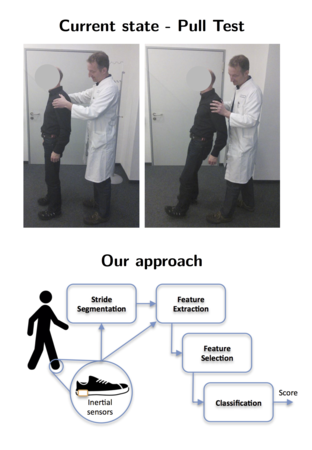
Dr. Cristian Pasluosta
Alumnus of the Pattern Recognition Lab of the Friedrich-Alexander-Universität Erlangen-Nürnberg
-
-
Postural instability is one of the main motor impairment of Parkinson’s disease (PD). The Pull Test is the most common clinical examination to assess postural instability in PD. However, the subjectivity and low discriminative power of this test presents as a major drawback. In this paper we propose a novel methodology to estimate the Pull Test scores from patients with PD. We capture the relationship between the Pull Test outcomes and patients’ foot motion patterns, using wearable sensors mounted on their shoes. 139 idiopathic Parkinson’s disease patients performed four motor function tests, including walking and repetitive foot motions, while acceleration and orientation data was recorded. A total of 684 features were extracted from the acceleration and orientation signals. Feature selection and classification algorithms were utilized to estimate the Pull Test score for each participant. Further, we estimate which motor function test would better predict the Pull Test score, depending on the patient’s phenotype (i.e. bradykinetic, tremor-dominant or equivalent). When combining all phenotypes and all tests, the mean of the classification probability distribution achieved was 0.75 (CI: [0.69 – 0.82]). Foot circling was the best predictive test for the equivalent patients (mean= 0.79, CI: [0.69 – 0.87]) and the bradykinetic patients (mean: 0.75, CI: [0.64 – 0.85]), while 2x10 m. walk with stop-and-go proved superior for the tremor- dominant patients (mean: 0.75, CI: [0.64 – 0.85]). Overall, these results suggest that inertial data from patient’s foot motion can be used to estimate postural instability in PD patients.

-

-
-
Current challenges demand a profound restructuration of the global healthcare system. A more efficient system is required to cope with the growing world population and increased life expectancy, which is associated with a marked prevalence of chronic neurological disorders such as Parkinson’s disease (PD). One possible approach to meet this demand is a laterally distributed platform such as the Internet of Things (IoT). Real-time motion metrics in PD could be obtained virtually in any scenario by placing lightweight wearable sensors in the patient’s clothes and connecting them to a medical database through mobile devices such as cell phones or tablets. Technologies exist to collect huge amounts of patient data not only during regular medical visits but also at home during activities of daily life. These data could be fed into intelligent algorithms to first discriminate relevant threatening conditions, adjust medications based on online obtained physical deficits, and facilitate strategies to modify disease progression. A major impact of this approach lies in its efficiency, by maximizing resources and drastically improving the patient experience. The patient participates actively in disease management via combined objective device- and self-assessment and by sharing information within both medical and peer groups. Here, we review and discuss the existing wearable technologies and the Internet-of-Things concept applied to PD, with an emphasis on how this technological platform may lead to a shift in paradigm in terms of diagnostics and treatment.

-
Photoplethysmography (PPG) is a non-invasive, inexpensive and unobtrusive method to achieve heart rate monitoring during physical exercises. Motion artifacts during exercise challenge the heart rate estimation from wrist-type PPG signals. This paper presents a methodology to overcome these limitation by incorporating acceleration information. The proposed algorithm consisted of four stages: (1) A wavelet based denoising, (2) an acceleration based denoising, (3) a frequency based approach to estimate the heart rate followed by (4) a postprocessing step. Experiments with different movement types such as running and rehabilitation exercises were used for algorithm design and development. Evaluation of our heart rate estimation showed that a mean absolute error 1.96bpm (beats per minute) with standard deviation of 2.86bpm and a correlation of 0.98 was achieved with our method. These findings suggest that the proposed methodology is robust to motion artifacts and is therefore applicable for heart rate monitoring during sports and rehabilitation.

 +49 9131 85 20159
+49 9131 85 20159
 +49 9131 85 27270
+49 9131 85 27270

